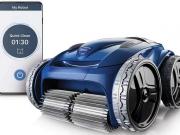
Keeping robots balanced while they perform tasks is not always straightforward. Bernd Henze, Máximo A. Roa, and Christian Ott from Institute of Robotics and Mechatronics (DLR), have introduced a new control approach that allow robots to use a subset of their end effectors to stay balanced while the remaining ones are used to interact with the surrounding environment.
The controller regulates the center of mass location, hip orientation, and poses of each end effector. As the researchers explain:
The controller includes a non-strict task hierarchy, which allows the robot to use a subset of its end effectors for balancing while the remaining ones can be used for interacting with the environment. The controller creates a passive and compliant behavior for regulating the center of mass (CoM) location, hip orientation and the poses of each end effector assigned to the interaction task. This is achieved by applying a suitable wrench (force and torque) at each one of the end effectors used for interaction.
The TORO robot was used to run these experiments.
[HT]













































